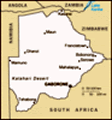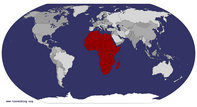Advertisement
Published: February 3rd 2012

 Chobe River Ferry 1
Chobe River Ferry 1
Zambian Ferry PointI will let Barbe tell you about the things we saw and did in Botswana this past week (January 26 - February 1, 2012). I want to focus on how we got there and back (to Livingstone, Zambia), as well as our most interesting accommodations so far.
We booked a week long sojourn with Acacia Tours back in Canada (although a British company), and their driver picked us up at the hostel where we were staying. This driver lives immediately across the border (across "the falls", really) in Zimbabwe, and he drove us to the ferry which gets you across the border into Botswana from Zambia. He explained that there are 2 ferries, the one run by Zambians and of somewhat doubtful quality (but more popular with the locals because cheaper) and the one run by Botswanans, of visibly better quality. Even though Angus took his SUV across, we passengers had to walk on the ferry (a safety precaution). It's only a 5 minute ride, and from the Botswanan landing you can see Namibia, across the fork of the Chobe and Zambezi rivers. A few miles further up the Zambezi you would get to the Angola border, so 5 countries
meet in a small space.
In Botswana we met our driver/guide for the week, Kaiser, as well as our truck. This was a modified Land Cruiser with extended wheel base to carry a custom built truck box which was fitted with 5 padded benches. We had a roof, but the top two thirds of the walls were open. On each side a canvas and vinyl (see-through) wall could be rolled down and clipped to provide SOME protection from the rain. Who knew it was the rainy season in this part of Africa, when it's dry further east and north?
We drove a few kms into the nearest town of Kasangula where we met our cook K.B., and collected a trailer with the extra camping equipment that we would pull around all week. We also stocked up on drinks (water, beer, my favourite Savannah cider from RSA), the main item almost never included in what you pay for "board" on African tours. With only one other client, Lucas from Switzerland, this gave us the best staff to guest ratio yet. But those two guys were responsible for our every need for the next 7 days, from pit latrine digging

 Ferrying Across The Chobe River
Ferrying Across The Chobe River
Saying Goodbye To Zambia (For Now)to middle of the night toilet escort (see the park warning about lions that will eat you, and Barbe's next post).
The routine for the day began with a drive to the campsite. Harder than it sounds, when the main roads around this part of northern Botswana are essentially sand tracks. We would then help set up our tents for the night. B and I shared an old style canvas dome tent, 6x6, in which you could stand in the very centre, with a sewn-in vinyl floor and mosquito net covered windows on all 4 sides with flaps that could be lowered for when it rains. WHEN IT RAINS... As long as you had nothing touching the sides of the tent (that old Girl Guide camping rule I've never forgotten) you could stay dry. Unfortunately, the tent furniture, when set up, inevitably touched the sides of the tent so that it leaked, as I learned the first night when I seemed to sleep with a small puddle under my left shoulder. The furniture was welcome thos: 2 camp cots keeping you 18 inches off the floor and thus providing a space to stow luggage underneath, and a 2 inch
foam mattress with cloth cover (for our old bones). Luckily it was pretty hot all week, and we never even used our sleeping bags (read "sponges"), just the sheet liners we brought, and everything would dry pretty quickly in the sun the next day. By the 4th night we learned a system for keeping things dry until we went to bed, and after. Mostly Barbe's genius, and she never even was a Girl Guide!
Additional set up for the night included building two "stall" enclosures with steel tubing and a tarp tied 7/8ths of the way around, one for shower and one for toilet. Toilet was an 18 inch hole dug in the soft sand, with a pot and seat structure over top, cleaner than any public toilet we've seen so far in Africa. And since the falling rain mostly goes sideways, the roofless structure was usually quite dry, if the wind didn't entirely blow it over! The shower was rarely filled with hot water, but you really appreciated a cool spray at the end of the day anyway. Finally there was a "mess tent" for cooking and eating, which was just a roof, or with one wall added
if rain threatened.
Then by 4:00 pm or so we would leave K.B. in camp to cook dinner while we went on our evening game drive. We would come back to a delicious dinner, with "carnivore" and "herbivore" dishes carefully separated. This was the running joke all week, but we were very well fed. After dinner there was little to do in the dark (except for K.B., who was busily making our lunch for the next day, to be stored in the battery powered cooler), so we were often in bed by 8:30. We could also use the truck's 2nd battery to charge our cameras, if the guys weren't using the two plugs for their phones ...
Then we were up again often by 5:30. (I could hear K.B. getting breakfast ready as early as 4:00 a.m.) We'd have a light breakfast and then head out on our morning game drive, leaving K.B. to deal with dishes and breaking camp all by himself. We'd be back after 10:00 to find the trailer all packed and K.B. napping on any suitable horizontal surface. Then we set off on the bumpy roads for the next camp, with plenty to see
along the way.
Much of what we saw could not be seen without a specialized vehicle and an expert professional driver. We chose this small-group Botswana tour precisely because, although we are going back through Botswana with the "overland" tour later, we knew we would not see as much in their bigger and less versatile trucks. The roads from Chobe to Savuti, and then from Savuti to Moremi, are very difficult, mostly deep, packed sand tracks. There were a few times, even in our vehicle, when we got partially stuck in some softer sand and Kaiser had to use some creative measures to get us out. Pulling the trailer made it that much trickier to reverse out of trouble spots. The driver and cook up front had no side protection from rain at all. Luckily we didn't have to drive very far in any rain, because then it all blows back and we would all have been wet - but they do supply rain ponchos!
Our truck actually had some transmission problems one afternoon but the tour company sent an identical alternate truck from Maun with 2 mechanics by bed-time. They got it fixed by the following morning,

 'Road' To Savuti
'Road' To Savuti
'Road' To Savutior would have let us go in the spare truck. The tracks are also narrow and quite overgrown by young trees, requiring Kaiser to shout warnings if some branch (usually some acacia tree with deadly thorns like nails) was going to swing in your face. From Savuti to Moremi their were also trees down all over the road... Looked like Hurricane Juan, but caused by elephants breaking their own path through the forest.
The Botswanans are also very concerned about animal hygiene. I think beef is one of their big exports. To get into the country, and a number of times on roads within the country, you had to pass through a chemical "dip" for the trucks, and all passengers had to exit and step on a chemical wetted mat. This is to prevent the transmission of hoof and mouth disease, should there be an outbreak in one region. But all the cows, goats and donkeys seemed very happy, thinking the highways and roads belonged to them, and only leisurely getting out of the way when a vehicle needed to pass.
The camping was a little different when we got to Maun, the main tourist centre for northern
Botswana. Here we stayed in a private commercial camp-ground instead of a wilderness site in a national park. There were established toilet and shower facilities, as well as electric lights about the place. Also a pool, but of a colour that left me less than excited for a dip. Then there was the ubiquitous bar. This gave us a flavour of what our next three weeks of large truck overlanding will be, as there were 3-4 of those in the campground those 2 nights.
The bar has a t.v. with satellite hook-up (not so rare, as I saw more than one straw hut in the tiniest village with a dish...). This meant we could watch the African Cup of Nations soccer tournament that is on right now. Unfortunately the Botswanan Zebras were eliminated fairly early on. This just meant that K.B. was now rooting for the Zambian team, who are currently 2nd in the standings, with another game scheduled for Saturday night. All the bars in Livingstone should be hopping.
Mon
Advertisement
Tot: 0.04s; Tpl: 0.014s; cc: 7; qc: 24; dbt: 0.0162s; 1; m:domysql w:travelblog (10.17.0.13); sld: 1;
; mem: 1.1mb















